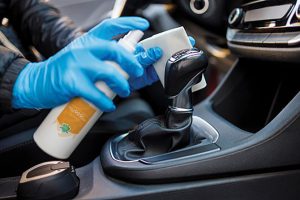By Joe George
COVID-19 has delivered a gut punch to the automotive industry,
the likes of which we haven’t seen before, including mobility. And while there’s universal agreement the future is still fleets and ACES (Autonomous and Aerial, Connected, Electric and Shared), the path will be different from what we projected even six months or a year ago. Here are the ways I believe mobility will change — or stay the same — in the next 12 to 18 months.
Ride-hailing and car-sharing isn’t making a big comeback any time soon
When’s the last time you got into a Lyft or an Uber? If you’re like me and most of America, it’s been months. Our April research indicated 31% of consumers planned to wait at least four months — or until a vaccine is available — before getting in a Lyft or Uber, with another 19% unsure. With cases ticking up again, I imagine current research would have similar findings.
People are returning to work, which means business will start to pick up slightly for ride-hailing companies. To meet changing consumer expectations, they’ll have to continue adjusting policies and procedures. I also expect to see more and deeper ride-hailing/public transit partnerships as that will likely help both parties reach commuters at scale.
Even when virus fears subside, Lyft and Uber will continue to feel the impacts of many companies adopting generous, new work-from-home policies and of the tourism market having a long road to recovery.
High volume of delivered goods will continue growing
With more people working from home and nervous about the coronavirus, restaurant takeout, grocery deliveries and Amazon deliveries are soaring.
“2020 is setting up to be an e-commerce inflection year as the combination of shelter-in-place, lower spend on experiences (dining out, bars, travel, etc.) and [government] stimulus have driven dollars online,” according to analysts at Morgan Stanley.
What does all this mean for mobility? We’re going to continue to see declining personal vehicle use and increasing fleet vehicle use, whether those fleet vehicles are personally or commercially owned. And those fleet vehicles, as they incur more miles and wear and tear inside and out, are going to need to be serviced more frequently.
Consumers will continue to demand sanitization and convenience
Many of us are dousing our hands, phones and/or credit cards with sanitizer at least once a day. The idea of having a vendor in our homes or cars creates anxiety and uncertainty. This anxiety will be engrained in our subconscious for years to come, in a similar way to experts projecting less handshaking and hugging for the foreseeable future. Not surprisingly, via our 2020 Cox Automotive COVID-19 Consumer & Impact Study, we found 83% of U.S. consumers polled say it’s extremely/very important for the dealership to disinfect vehicle surfaces after a service or test drive.
Beyond dealerships, automobile, bus, train and air fleet owners/operators and ride-share providers also recognize the need to disinfect (not just clean) their vehicles and cabins regularly, especially now. RideKleen and its PureProtect solution is positioned well to lead in the market. RideKleen-performed services and product solutions use an EPA-registered approved antimicrobial product that kills up to 99.9% of germs, bacteria, mold, mildew and emerging viruses. Moreover, PureProtect inhibits the growth of harmful germs, mold and mildew for up to 30 days post-treatment — keeping vehicles protected for an extended period of time.
In addition to disinfecting vehicles, dealerships who implement “touchless interactions,” such as valet pickup and drop-off programs, drive sales and service revenue while safely meeting customers’ needs.

Consumers will continue to appreciate the safety aspects of at-home service pickup and delivery or retail delivery but will come to really appreciate the convenience. Dealers who cancel these services when the pandemic subsides will be shooting themselves in the foot. According to Cox Automotive’s COVID-19 U.S. Consumer and Automotive Dealer Sentiment research, five out of 10 vehicle owners prefer to use service pickup and delivery the next time they need to service their vehicle at the dealership. The same internal research revealed that, despite high consumer demand and preference, many dealers plan to discontinue offerings like digital retailing and service pickup and delivery once things get back to “normal.” Dealers who elect to continue offering these solutions post COVID-19 will develop a clear competitive advantage over others, with seven out of 10 vehicle owners likely to choose one dealership over another based on the availability of service pickup and delivery.
Credit challenges will drive an increase in vehicle subscriptions over traditional buying or leasing — especially in the subprime market
A subprime auto loan is a type of financing for a car purchase that’s offered to people with low credit scores or limited credit histories. Over the last few years, new car prices have risen higher and higher, making it harder for some consumers to afford new cars.
To counter this trend, the industry has responded by extending the average loan duration and subsidizing the financing costs. And now COVID has caused additional financial strain across America. Despite efforts such as stimulus packages, lots of responsible people have experienced unexpected financial hardships.
I expect credit challenges to drive consumers to the subscription model, which also provides more flexibility (i.e., month-to-month payments vs. long-term commitment). This hunch is validated by our research, which indicates half the shoppers now say they are interested in single-vehicle subscription. Why would subscription work for some consumers who struggle to get reasonable interest rates with traditional ownership? Traditional credit underwriting focuses on predicting the likelihood of a consumer to make years of payments in a row. Subscription, which in most cases is a month to month commitment, doesn’t require a multi-year underwriting decision. Instead, it relies more on the likelihood of the consumer taking care of a vehicle and returning it in good shape.
Many of us know people that have historically been responsible but have recently taken hits to their financial situation. These individuals may not score well on traditional credit models, but these consumers are likely to drive safely and take good care of their vehicles.
By owning a fleet of subscription vehicles, dealers can take advantage of a low cost of commercial borrowing and “lend this low cost of capital” to consumers that are likely to take care of the vehicle but don’t qualify for favorable financing rates.
Electric growth will hit the brakes, but not stop
No, it doesn’t take a rocket scientist to surmise that electric vehicles (E.V.s) aren’t a pressing priority for automakers, or that consumers are pushing out vehicle purchases amid economic uncertainty (approximately one in three shoppers is currently delaying purchase).
How long an E.V. stall-out will last is the big question mark. The reality is that the future is/will be electric, as carmakers must work toward meeting strict emissions targets. Many manufacturers have spent billions of dollars in research on E.V. technology, which has been underway for years.
Although the vast majority of Americans agree that if we all drove electric vehicles, we could reduce oil consumption and pollution, only a third would consider buying one anytime soon. And it’s largely due to the fact that the industry is still early in when it comes to educating and delivering proof about the real or perceived consumer pain points of cost, access to charging and battery health. Don’t forget that historically low gas prices make combustible engines more attractive than E.V.s to many consumers.
I encourage everyone reading this to keep an eye on the E.V. market and be open-minded when it comes to purchasing your next vehicle and encourage your friends and family to do the same. Kelley Blue Book tells us the average 5-Year Cost-to-Operate savings is significant for some E.V.s versus their gas-powered counterparts — 58% overall, with 60% in fuel savings and 25% in service cost savings over five years — so E.V. costs less.
If you’re worried about charging, as many consumers are, keep in mind that 80% of charging takes place at home or work — if you have that luxury. As it relates to batteries, it’s reasonable to be concerned about battery health. After all, 51% of an electric vehicle’s value is tied to the E.V. powertrain versus the powertrain of an internal combustible engine being 18%. It’s also promising to know that most E.V.s come with 100,000-mile warranties and that battery enhancement gets introduced every year to improve range, safety and cost.
Joe George is President of Cox Automotive Mobility.
This story appears in Issue 2 2020-21 of the New Jersey Auto Retailer Magazine.







